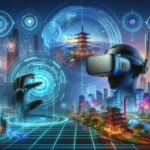Unlocking the Future: How Augmented Reality and AI are Transforming Business in 2024 🚀
The Evolution of Augmented Reality
In recent years, augmented reality (AR) has moved significantly beyond its initial entertainment-focused applications. By 2024, AR is emerging as a powerful business tool, reshaping various industries. Companies are recognizing the potential of AR to enhance customer experiences, improve operational efficiency, and drive innovation like never before.
The Impact of Artificial Intelligence on AR
Artificial intelligence (AI) is playing a crucial role in enhancing AR experiences. With advancements in AI algorithms, businesses are now able to
- Create realistic human models that elevate immersive training sessions and product demos.
- Implement object detection and labeling to enhance user interactions and streamline operations.
- Facilitate text recognition and translation, improving accessibility for diverse audiences.
Moreover, AI assists with AR device setup and troubleshooting. This enhanced support not only improves user experiences but also boosts operational efficiency, allowing businesses to focus more on innovation.
Revolutionizing Workflows with AR and AI Integration
The integration of AR and AI is unlocking unprecedented possibilities for business solutions. For instance, companies are employing AR in onboarding processes, providing new employees with interactive tutorials. Likewise, maintenance troubleshooting is becoming more efficient with AR-guided instructions, leading to significant time and cost savings.
The Shift Toward the Metaverse
The advancement of AR technologies is steering the industry towards the metaverse concept. This immersive digital landscape is focused on realistic avatars and enhanced social interactions. Here’s how the transition is taking place:
- The development of realistic avatars enriches user engagement in virtual environments.
- Enhanced social interactions create opportunities for collaboration across distance, breaking geographical barriers.
Mobile and WebAR: Accessibility at Your Fingertips
Mobile AR is rapidly becoming an essential tool for businesses, equipping them with functionalities such as:
- Remote assistance, allowing experts to guide users through complex tasks from afar.
- Training programs that simulate real-life scenarios, enhancing learning outcomes.
- Product visualization, enabling customers to see how products fit into their environments before purchasing.
On the other hand, WebAR is gaining traction due to its accessibility. With the ability to provide simpler AR experiences directly through web browsers, businesses can reach wider audiences without the need for app downloads. This boosts user engagement and lowers entry barriers for customers.
Crosstalk: Cross-Platform AR Applications
Developers are pushing toward cross-platform AR applications that aim to target broader audiences. However, challenges such as consistency and quality compared to native applications remain. Despite this, the potential for cross-platform experiences opens new avenues for user engagement and market penetration.
Wearable AR: The Next Frontier
The rise of wearable AR experiences, exemplified by devices like Apple’s Vision Pro, is offering businesses exciting new opportunities. These devices can:
- Enhance real-time information delivery for users.
- Improve workplace productivity by overlaying crucial data onto physical environments.
- Provide intuitive and immersive experiences in sectors such as retail and healthcare.
Industry Applications of AR
From enhancing marketing strategies to improving training protocols, AR is being widely adopted across various industries including:
- Marketing</—Creating interactive advertisements that engage customers.
- Healthcare—Enabling surgeons to visualize 3D models during operations, improving precision.
- Retail—Allowing customers to try products virtually before buying.
- Manufacturing—Streamlining maintenance processes and increasing workplace safety.
- Automotive—Presenting advanced navigation systems and interactive dashboards.
Future Prospects: A Growing Market
The future of AR technology is intricately connected to the advancements in AI, with a significant growth trajectory projected for the market. As businesses continue to leverage AI, mobile AR, and wearable devices, significant enhancements to customer experiences, operational efficiencies, and innovative solutions are anticipated.




0 Comments